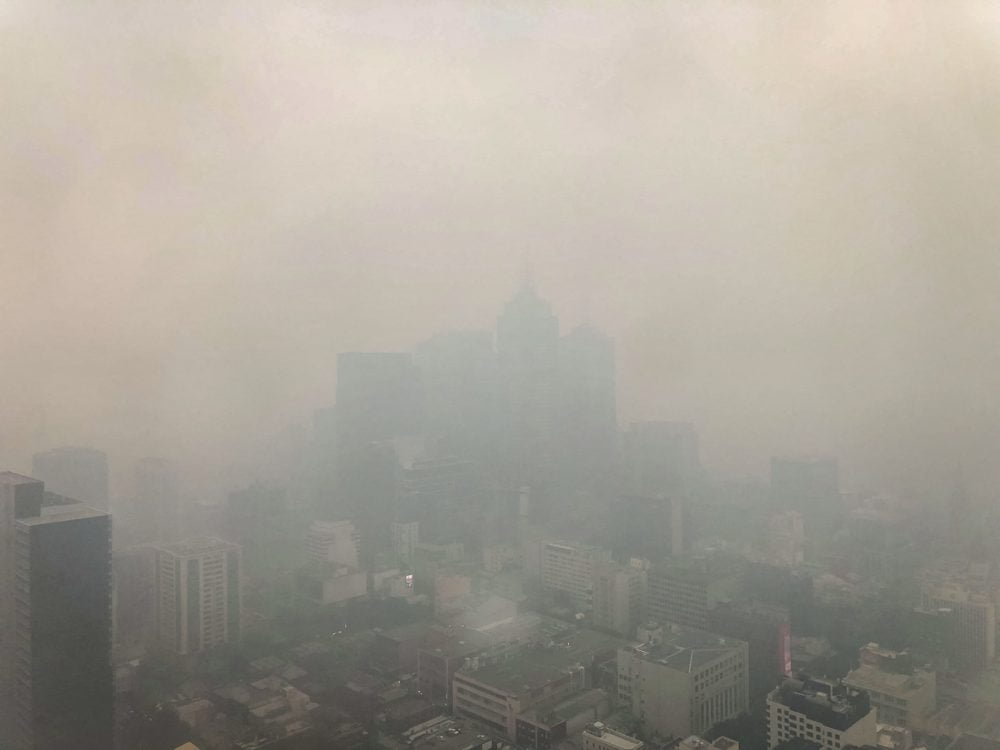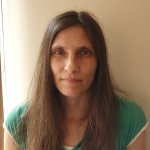In this blog, researcher Sadia Janjua talks about a Cochrane ReviewCochrane Reviews are systematic reviews. In systematic reviews we search for and summarize studies that answer a specific research question (e.g. is paracetamol effective and safe for treating back pain?). The studies are identified, assessed, and summarized by using a systematic and predefined approach. They inform recommendations for healthcare and research. in progress on measures people can take to reduce exposure to air pollution and Hariklia Nguyen, who contributed a personal perspective to the review protocolThe plan or set of steps to be followed in a study. A protocol for a systematic review should describe the rationale for the review, the objectives, and the methods that will be used to locate, select, and critically appraise studies, and to collect and analyse data from the included studies. The protocols for Cochrane Reviews are available in the Cochrane Library., writes about her recent experiences during the Australian bushfires and the need for this evidence.
Page updated 04 January 2022; page checked 9 May 2023.
The Cochrane Review, Individual‐level interventions to reduce personal exposure to outdoor air pollution and their effects on people with long‐term respiratory conditions, was published on 09 August 2021. It reveals an evidence gap about the effectivenessThe ability of an intervention (for example a drug, surgery, or exercise) to produce a desired effect, such as reduce symptoms. and safetyRefers to serious adverse effects, such as those that threaten life, require or prolong hospitalization, result in permanent disability, or cause birth defects. of things individuals can do to reduce their exposure to air pollution.
Take-home points
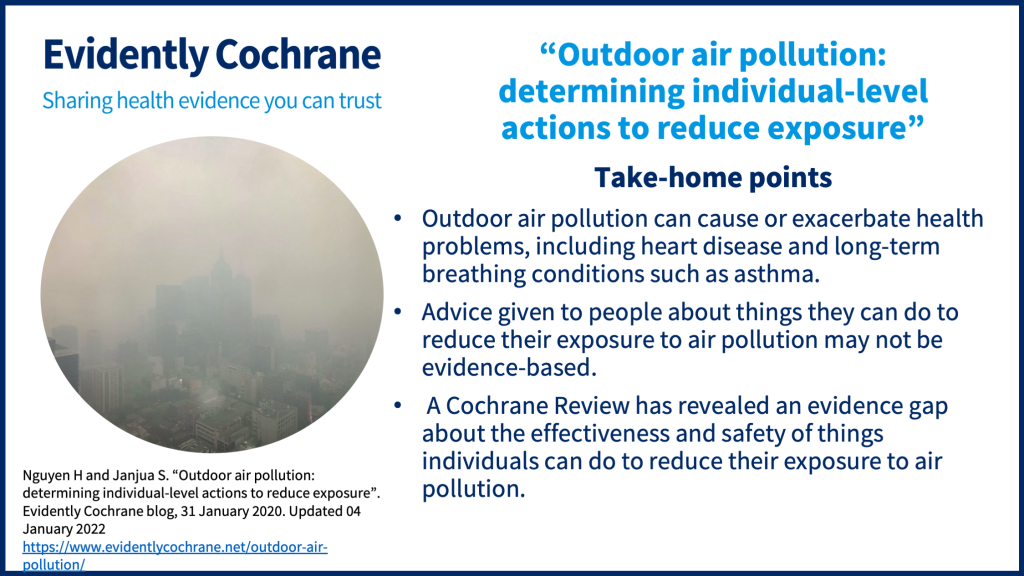
Cochrane author, Sadia:
Outdoor air pollution is major problem globally at the moment, and can cause and exacerbate health problems including heart disease and long-term breathing conditions. People who already have breathing problems such as asthma, ChronicA health condition marked by long duration, by frequent recurrence over a long time, and often by slowly progressing seriousness. For example, rheumatoid arthritis. Obstructive Pulmonary Disease (COPD) or Cystic Fibrosis are particularly affected.
We decided to write a systematic reviewIn systematic reviews we search for and summarize studies that answer a specific research question (e.g. is paracetamol effective and safe for treating back pain?). The studies are identified, assessed, and summarized by using a systematic and predefined approach. They inform recommendations for healthcare and research. on this topic after meeting a group of people from London with COPD. Several members of the group said that they changed their behaviour in response to high air pollution. This included avoiding busy roads, wearing a scarf across the mouth and nose, closing windows, and using air quality alert mobile phone apps. They wanted to know what the evidence was behind these behaviour changes that they were making. A few of the group members said that they were given advice by their health care professionals, but they wanted to know what evidence there was behind the advice.
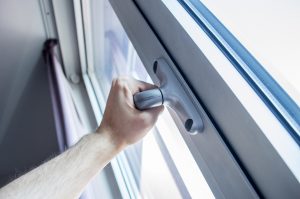
Our new review Individual-level interventions to reduce personal exposure to outdoor air pollution and their effects on long-term respiratory conditions will look at the information that already exists from research studies about the effectiveness and safety of things that people with long-term breathing conditions can do to avoid air pollution (e.g. wear a mask, stay indoors, or use air pollution apps). We were fortunate to have Hariklia Nguyen who provided valuable input, as someone who lives with sarcoidosis, on our published protocol. A Cochrane Protocol is a plan for a full Cochrane Review. A Cochrane Protocol outlines the healthcare question that will be addressed, and describes the methods that will be used in the Cochrane Review. The information contained within a Cochrane Protocol will be included in the full Cochrane Review when it is completed.
The need for this information has been highlighted again with the recent bushfires affecting so many people in Australia, including Hariklia, as she explains here.
Cochrane Citizen Scientist Hariklia:
I experience the typical sarcoidosis symptoms such as episodes of a dry cough, flu like symptoms, sometimes shortness of breath and tiredness. I reside in Victoria, the Australian state, and I recently experienced the effects of the horrific bushfires that people around the world have seen on the news. This caused a long period of very dusty and smoky air in Melbourne, with air quality alternating from hazardous to very poor. It meant that anyone could experience symptoms like coughing or shortness of breath. This is quite rare or in my view unheard of. It was a really unpleasant experience which I’d like to share with you, and one that was made worse because of the practical difficulties of following some of the advice given – and a lack of evidence about what works!
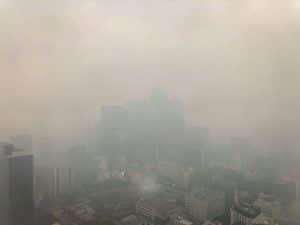
Official advice was to stay indoors and keep windows and doors closed. This did affect me as I had a period of coughing, breathing difficulties and sneezing. I had many thoughts about this information. How would I know if the air quality inside my home was already affected by the poor outdoor air quality? Am I safe in my own home?
Following advice can be difficult
It did not take long to realise that finding apps that monitor indoor air quality was difficult. During my search for mobile apps the free apps I managed to locate were ones linked with a separate portable air quality device you can purchase for your home which are costly. I tried other apps that could monitor outdoor pollution (apps that can monitor air quality where you live to ensure the information will be more accurate) hoping they had the capability to monitor the indoor air quality too but unfortunately, they didn’t. Eventually I gave up because it took time to download the apps on my mobile device and try them! Furthermore, some required that you register or sign in to use them which I found unappealing.

Tips on reducing exposure to air pollution are not always practical
The other advice also was to switch air-conditioners to recirculate if using them indoors and if your unit doesn’t have that function, to turn it off. However, during this time of the bush fires we were experiencing hot and humid days and so staying in the house without the air conditioner switched on was almost impossible. The advice included giving consideration to going to an air-conditioned building like a library or shopping centre for a break if safe to do so. If I could be sure the air quality in my home is poor, then it may help to make a decision to take the riskA way of expressing the chance of an event taking place, expressed as the number of events divided by the total number of observations or people. It can be stated as ‘the chance of falling were one in four’ (1/4 = 25%). This measure is good no matter the incidence of events i.e. common or infrequent. to leave home which would expose me to outdoor hazardous air (even though for a short period) while going to a place where the indoor quality may be better. Unfortunately, you cannot always leave your house and go somewhere else especially for long periods of time. These tips were not always practical during the summer or heat period!
Advice can cause confusion
My community was further advised to wear masks but at the same time it was not known if they were effective! I am sure this caused confusion among the community. Apparently, there was also a shortage of these masks which the country was unprepared for. Indeed, Guy Marks from the University of New South Wales is putting together an expert Australian team to research poor air quality, the effects and what could prevent exposure in these situations. He comments “Are masks even that effective? What about air filtration? Or staying indoors. We’re not sure that any of that is right, but they’re all testable questions.”

We need evidence-based answers to questions!
I agree! As a community member I would like the answers to all of these questions! This also relates to the key question in the new Cochrane Review – Individual-level interventions to reduce personal exposure to outdoor air pollution and their effects on long-term respiratory conditions: what can individuals do, especially those with long-term breathing conditions, to reduce their exposure to air pollution?
Sadia:
We are hoping that our review will find out what evidence there is behind advice given to people with respiratory conditions when air pollution is poor, and whether what they are doing to reduce their exposure to air pollution is effective in improving their health.

Join in the conversation on Twitter with @CochraneAirways @CochraneUK or leave a comment on the blog.
Sadia Janjua joined Cochrane Airways in January 2018 as a Systematic ReviewerSomebody responsible for preparing and, in the case of Cochrane Reviews, keeping up-to-date a systematic review. The term ‘reviewer’ is also sometimes used to refer to an external peer reviewer, or referee. having worked in the same position at the National Guideline Alliance (NGA) based in the Royal College of Obstetricians and Gynaecologists where she worked on women’s and children’s clinical guidelines for NICE. Sadia’s PhD was based on signalling mechanisms in programmed cell death. She is currently working on a suite of reviews that reflect NHS priorities in the management of chronic respiratory disease.
Hariklia Nguyen’s biography appears below.
Disclosure of interest
Hariklia Nguyen reports the following activities or associations: Volunteers her time as a Cochrane Consumer‘Consumer’ is Cochrane’s preferred term for patients (or someone with personal experience of a health condition), care-givers or family members of someone with a health condition. (https://consumers.cochrane.org) reviewer and has reviewed the published protocol – Individual-level interventions to reduce personal exposure to outdoor air pollution and their effects on long-term respiratory conditions. Volunteers her time as a Crowd Citizen Scientist identifying randomisedRandomization is the process of randomly dividing into groups the people taking part in a trial. One group (the intervention group) will be given the intervention being tested (for example a drug, surgery, or exercise) and compared with a group which does not receive the intervention (the control group). or quasi-randomised trialsClinical trials are research studies involving people who use healthcare services. They often compare a new or different treatment with the best treatment currently available. This is to test whether the new or different treatment is safe, effective and any better than what is currently used. No matter how promising a new treatment may appear during tests in a laboratory, it must go through clinical trials before its benefits and risks can really be known. and other related tasks. Member of and Volunteer for the Alpha-1 AssociationA relationship between two characteristics, such that as one changes, the other changes in a predictable way. For example, statistics demonstrate that there is an association between smoking and lung cancer. In a positive association, one quantity increases as the other one increases (as with smoking and lung cancer). In a negative association, an increase in one quantity corresponds to a decrease in the other. Association does not necessarily mean that one thing causes the other. of Australia (No financial or any other involvement or influence in regards to her blog piece, any protocols, reviews or other Cochrane related works or roles).
Sadia Janjua has nothing to disclose.

